

Compact Muon Solenoid
LHC, CERN
| CMS-BPH-19-003 ; CERN-EP-2019-288 | ||
| Study of excited $\Lambda_{\mathrm{b}}^{0}$ states decaying to $\Lambda_{\mathrm{b}}^{0}\pi^{+}\pi^{-}$ in proton-proton collisions at $\sqrt{s} = $ 13 TeV | ||
| CMS Collaboration | ||
| 18 January 2020 | ||
| Phys. Lett. B 803 (2020) 135345 | ||
| Abstract: A study of excited $\Lambda_{\mathrm{b}}^{0}$ baryons is reported, based on a data sample collected in 2016-2018 with the CMS detector at the LHC in proton-proton collisions at a center-of-mass energy of 13 TeV, corresponding to an integrated luminosity of up to 140 fb$^{-1}$. The existence of four excited $\Lambda_{\mathrm{b}}^{0}$ states: $\Lambda_{\mathrm{b}}(5612)^{0}$, $\Lambda_{\mathrm{b}}(5620)^{0}$, $\Lambda_{\mathrm{b}}(6146)^{0}$, and $\Lambda_{\mathrm{b}}(6152)^{0}$ in the $\Lambda_{\mathrm{b}}^{0}\pi^{+}\pi^{-}$ mass spectrum is confirmed, and their masses are measured. The $\Lambda_{\mathrm{b}}^{0}\pi^{+}\pi^{-}$ mass distribution exhibits a broad excess of events in the region of 6040-6100 MeV, whose origin cannot be discerned with the present data. | ||
| Links: e-print arXiv:2001.06533 [hep-ex] (PDF) ; CDS record ; inSPIRE record ; HepData record ; CADI line (restricted) ; | ||
| Figures | |

png pdf |
Figure 1:
Invariant mass distribution of the selected ${\Lambda_{\mathrm{b}}^{0} {\pi^{+} \pi^{-}}}$ candidates near threshold. The vertical bars on the data points display the statistical uncertainties in the data. The overall fit result is shown by the thick solid line, with the thin and dashed lines representing the signal and combinatorial background components, respectively. |

png pdf |
Figure 2:
Invariant mass distribution of the selected ${\Lambda_{\mathrm{b}}^{0} {\pi^{+} \pi^{-}}}$ candidates in the high-mass region. The vertical bars on the data points represent the statistical uncertainties in the data. The overall fit result is shown by the thick solid line. The thin lines present the contributions from the two signal peaks and the broad enhancement. The dashed line displays the combinatorial background. |
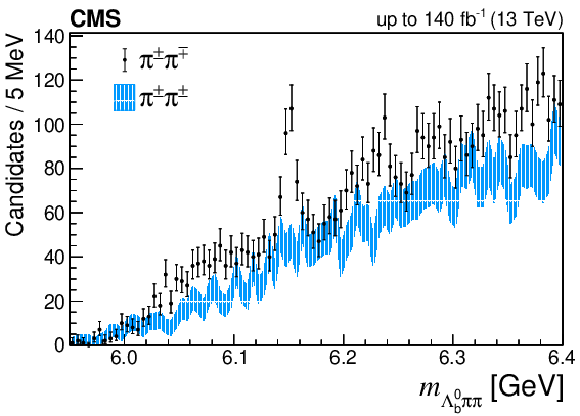
png pdf |
Figure 3:
Comparison of the invariant mass distribution of the selected ${\Lambda_{\mathrm{b}}^{0} {\pi^{+} \pi^{-}}} $ candidates in the SS background (band) and OS signal (points) channels. The vertical bars on the OS data points and the width of the bands for the SS distribution indicate the statistical uncertainties only. |
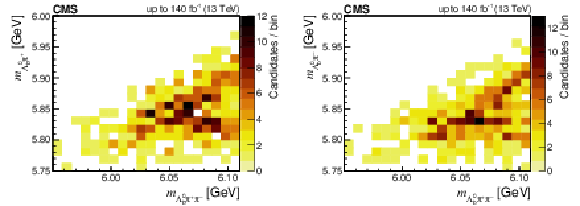
png pdf |
Figure 4:
Two-dimensional distribution of the ${\Lambda_{\mathrm{b}}^{0} {\pi^{+} \pi^{-}}} $ mass versus the ${\Lambda_{\mathrm{b}}^{0} {\pi^{+} }} $ mass (left) and ${\Lambda_{\mathrm{b}}^{0} {\pi^{-} }} $ mass (right), in the range $ {m_{\Lambda_{\mathrm{b}}^{0} {\pi^{+} \pi^{-}}}} < $ 6100 MeV. The scale on the right of each plot gives the number of candidates per 8 MeV $\times$ 12.5 MeV bin. |
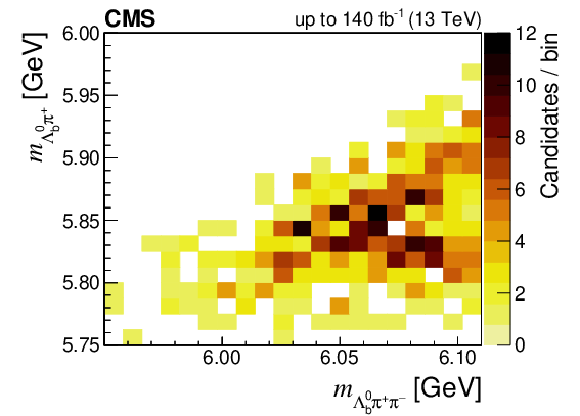
png pdf |
Figure 4-a:
Two-dimensional distribution of the ${\Lambda_{\mathrm{b}}^{0} {\pi^{+} \pi^{-}}} $ mass versus the ${\Lambda_{\mathrm{b}}^{0} {\pi^{+} }} $ mass. in the range $ {m_{\Lambda_{\mathrm{b}}^{0} {\pi^{+} \pi^{-}}}} < $ 6100 MeV. The scale on the right of the plot gives the number of candidates per 8 MeV $\times$ 12.5 MeV bin. |
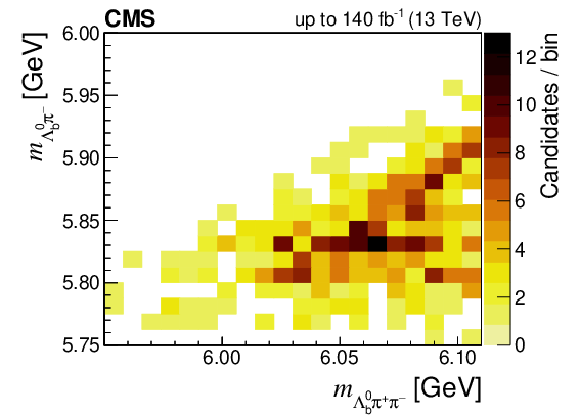
png pdf |
Figure 4-b:
Two-dimensional distribution of the ${\Lambda_{\mathrm{b}}^{0} {\pi^{+} \pi^{-}}} $ mass versus the ${\Lambda_{\mathrm{b}}^{0} {\pi^{-} }} $ mass. in the range $ {m_{\Lambda_{\mathrm{b}}^{0} {\pi^{+} \pi^{-}}}} < $ 6100 MeV. The scale on the right of the plot gives the number of candidates per 8 MeV $\times$ 12.5 MeV bin. |
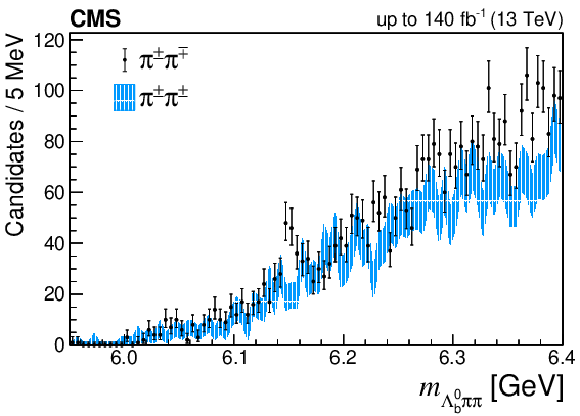
png pdf |
Figure 5:
The distribution of ${m_{{\Lambda_{\mathrm{b}}^{0} {\pi^{+} \pi^{-}}}}}$ for OS (points) and SS (band) candidates after the possible $\Sigma_{\mathrm{b}}^{\pm}$ and $\Sigma_{\mathrm{b}}^{*\pm}$ baryon contributions in the $\Lambda_{\mathrm{b}}^{0} {\pi^{\pm} } $ mass spectrum are vetoed. The vertical bars on the OS data points and the width of the band for the SS distribution indicate the statistical uncertainties only. |
| Tables | |

png pdf |
Table 1:
Systematic uncertainties (in MeV) in the measured masses. A dash means that the corresponding uncertainty is negligible, and "N/A" means that it does not apply. |
| Summary |
|
In summary, using the pp collision data recorded with the CMS detector at $\sqrt{s} = $ 13 TeV, corresponding to an integrated luminosity of up to 140 fb$^{-1}$, the existence of the $\Lambda_{\mathrm{b}}(5612)^{0}$ and $\Lambda_{\mathrm{b}}(5620)^{0}$ baryons is confirmed. Their masses, with respect to the $\Lambda_{\mathrm{b}}^{0}$ mass, are measured to be 292.72 $\pm$ 0.12 $\pm$ 0.01 MeV and 300.56 $\pm$ 0.07 $\pm$ 0.01 MeV, respectively, where the first uncertainty is statistical and the second is systematic. By adding the known $\Lambda_{\mathrm{b}}^{0}$ mass of 5619.60 $\pm$ 0.17 MeV [19], we report the mass measurements |
| References | ||||
| 1 | Y. Chen et al., eds. | Heavy quark effective theory | Springer, Berlin, Heidelberg, 2004 , ISBN 978-3-540-20692-7 | |
| 2 | S. Capstick and N. Isgur | Baryons in a relativized quark model with chromodynamics | PRD 34 (1986) 2809 | |
| 3 | H. Garcilazo, J. Vijande, and A. Valcarce | Faddeev study of heavy baryon spectroscopy | JPG 34 (2007) 961 | hep-ph/0703257 |
| 4 | D. Ebert, R. N. Faustov, and V. O. Galkin | Masses of excited heavy baryons in the relativistic quark model | PLB 659 (2008) 612 | 0705.2957 |
| 5 | W. Roberts and M. Pervin | Heavy baryons in a quark model | Int. J. Mod. Phys. A 23 (2008) 2817 | 0711.2492 |
| 6 | M. Karliner, B. Keren-Zur, H. J. Lipkin, and J. L. Rosner | The quark model and b baryons | Annals Phys. 324 (2009) 2 | 0804.1575 |
| 7 | J.-R. Zhang and M.-Q. Huang | Heavy baryon spectroscopy in QCD | PRD 78 (2008) 094015 | 0811.3266 |
| 8 | C. Garcia-Recio et al. | Odd parity bottom-flavored baryon resonances | PRD 87 (2013) 034032 | 1210.4755 |
| 9 | Y. Yamaguchi et al. | Heavy quark symmetry in multihadron systems | PRD 91 (2015) 034034 | 1402.5222 |
| 10 | J. M. Torres-Rincon, L. Tolos, and O. Romanets | Open bottom states and the $ \overline{\mathrm{B}} $-meson propagation in hadronic matter | PRD 89 (2014) 074042 | 1403.1371 |
| 11 | B. Chen, K.-W. Wei, and A. Zhang | Assignments of $ \Lambda_Q $ and $ \Xi_Q $ baryons in the heavy quark-light diquark picture | EPJA 51 (2015) 82 | 1406.6561 |
| 12 | K.-W. Wei et al. | Spectroscopy of singly, doubly, and triply bottom baryons | PRD 95 (2017) 116005 | 1609.02512 |
| 13 | K. Thakkar, Z. Shah, A. K. Rai, and P. C. Vinodkumar | Excited state mass spectra and Regge trajectories of bottom baryons | NP A 965 (2017) 57 | 1610.00411 |
| 14 | Z.-Y. Wang, J.-J. Qi, X.-H. Guo, and K.-W. Wei | Spectra of charmed and bottom baryons with hyperfine interaction | CPC 41 (2017) 093103 | 1701.04524 |
| 15 | K.-L. Wang, Y.-X. Yao, X.-H. Zhong, and Q. Zhao | Strong and radiative decays of the low-lying $ S $- and $ P $-wave singly heavy baryons | PRD 96 (2017) 116016 | 1709.04268 |
| 16 | Y. Kawakami and M. Harada | Singly heavy baryons with chiral partner structure in a three-flavor chiral model | PRD 99 (2019) 094016 | 1902.06774 |
| 17 | LHCb Collaboration | Observation of excited $ \Lambda_{\mathrm{b}}^0 $ baryons | PRL 109 (2012) 172003 | 1205.3452 |
| 18 | CDF Collaboration | Evidence for a bottom baryon resonance $ \Lambda_{\mathrm{b}}^{*0} $ in CDF data | PRD 88 (2013) 071101 | 1308.1760 |
| 19 | Particle Data Group, M. Tanabashi et al. | Review of particle physics | PRD 98 (2018) 030001 | |
| 20 | LHCb Collaboration | Study of beauty hadron decays into pairs of charm hadrons | PRL 112 (2014) 202001 | 1403.3606 |
| 21 | LHCb Collaboration | Observation of the decays $ \Lambda_\mathrm{b}^0 \to \chi_{\mathrm{c}1} \mathrm{pK}^- $ and $ \Lambda_\mathrm{b}^0 \to \chi_{\mathrm{c}2} \mathrm{p K}^- $ | PRL 119 (2017) 062001 | 1704.07900 |
| 22 | LHCb Collaboration | Observation of new resonances in the $ \Lambda_{\mathrm{b}}^{0}\pi^{+}\pi^{-} $ system | PRL 123 (2019) 152001 | 1907.13598 |
| 23 | CMS Collaboration | The CMS experiment at the CERN LHC | JINST 3 (2008) S08004 | CMS-00-001 |
| 24 | CMS Collaboration | The CMS trigger system | JINST 12 (2017) P01020 | CMS-TRG-12-001 1609.02366 |
| 25 | CMS Collaboration | Performance of CMS muon reconstruction in $ \mathrm{pp} $ collision events at $ \sqrt{s} = $ 7 TeV | JINST 7 (2012) P10002 | CMS-MUO-10-004 1206.4071 |
| 26 | CMS Collaboration | Description and performance of track and primary-vertex reconstruction with the CMS tracker | JINST 9 (2014) P10009 | CMS-TRK-11-001 1405.6569 |
| 27 | CMS Collaboration | CMS tracking performance results from early LHC operation | EPJC 70 (2010) 1165 | CMS-TRK-10-001 1007.1988 |
| 28 | CMS Collaboration | Search for the X(5568) state decaying into $ \mathrm{B}^{0}_{\mathrm{s}}\pi^{\pm} $ in proton-proton collisions at $ \sqrt{s} = $ 8 TeV | PRL 120 (2018) 202005 | CMS-BPH-16-002 1712.06144 |
| 29 | CMS Collaboration | Studies of $ {\mathrm {B}}^{*}_{\mathrm {s}2}(5840)^0 $ and $ {\mathrm {B}}_{{\mathrm {s}}1}(5830)^0 $ mesons including the observation of the $ {\mathrm {B}}^{*}_{\mathrm {s}2}(5840)^0 \rightarrow {\mathrm {B}} ^0 \mathrm {K} ^0_{\mathrm {S}} $ decay in proton-proton collisions at $ \sqrt{s}= $ 8 TeV | EPJC 78 (2018) 939 | CMS-BPH-16-003 1809.03578 |
| 30 | CMS Collaboration | Observation of two excited B$ ^+_\mathrm{c} $ states and measurement of the B$ ^+_\mathrm{c} $(2S) mass in pp collisions at $ \sqrt{s} = $ 13 TeV | PRL 122 (2019) 132001 | CMS-BPH-18-007 1902.00571 |
| 31 | T. Sjostrand et al. | An introduction to PYTHIA 8.2 | CPC 191 (2015) 159 | 1410.3012 |
| 32 | D. J. Lange | The EvtGen particle decay simulation package | NIMA 462 (2001) 152 | |
| 33 | E. Barberio, B. van Eijk, and Z. W\cas | PHOTOS --- a universal Monte Carlo for QED radiative corrections in decays | CPC 66 (1991) 115 | |
| 34 | E. Barberio and Z. W\cas | PHOTOS -- a universal Monte Carlo for QED radiative corrections: version 2.0 | CPC 79 (1994) 291 | |
| 35 | GEANT4 Collaboration | $ GEANT4--A $ simulation toolkit | NIMA 506 (2003) 250 | |
| 36 | G. Punzi | Sensitivity of searches for new signals and its optimization | in Statistical problems in particle physics, astrophysics and cosmology. Proceedings, Conference, PHYSTAT 2003, Stanford, USA, September 8-11, 2003, p. MODT002 2003 eConf C030908 | physics/0308063 |
| 37 | S. S. Wilks | The large-sample distribution of the likelihood ratio for testing composite hypotheses | Annals Math. Statist. 9 (1938) 60 | |
| 38 | G. Cowan, K. Cranmer, E. Gross, and O. Vitells | Asymptotic formulae for likelihood-based tests of new physics | EPJC 71 (2011) 1554 | 1007.1727 |

|
Compact Muon Solenoid LHC, CERN |

|

|

|

|

|

|